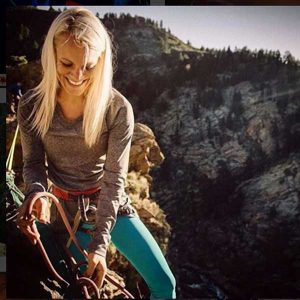Slacklining: Managing Fear in the Moment
01 Jun 2017
Heather Larsen prefers her slacklines to be hundreds of feet in the air
By Chris Van Leuven Where most slackliners practice their craft safely close to the ground, professional “slacker” Heather Larsen prefers to be hundreds of feet up in the air. She seeks out those high, still moments when she’s alone on the line, with nothing but air below her feet and surrounded by nature. Up there, performing her fluid spins, splits and yoga poses, calm replaces fear and she experiences a sense of moving meditation. She also assists with the complex labor required to rig highlines, which involves stringing highly tensioned flat webbing across vast expanses. In October 2016, she helped prepare the iconic Ivy Baldwin highline at the entrance to Eldorado Canyon for highliner Taylor VanAllen. The line was set up 582 feet above the ground, via 530 feet of tensioned webbing strung between the great, tilted sandstone cliffs. Legendary highwire walker Ivy Baldwin was the first to walk this line in Eldorado Canyon in the early- and mid-20th century in a daring feat called “the greatest in the world.” Over the years, his circus-like act attracted thousands of tourists who came to marvel at his bravery and grace. His steel anchors are still fastened to the cliff, remaining there as a part of history.
Being Outside vs. Paying Bills
Larsen grew up climbing trees and running through cornfields in Iowa and Minnesota. She has lived in 13 states but called Golden, Colo., home the longest, residing there for five years before moving to Salt Lake City two months ago. By day she works as an investment analyst. “It’s a bit backwards to what I do with slacklining,” she says. “You sit all day and look at a computer screen. I would rather be outside, but I have to pay my bills and need to set myself up for future success.”“It can be a happy excitement and the most terrifying feeling.”She could have taken the city path through life, but the Great Recession caused her to make a drastic change. After earning her degree in economics and finance in 2008, she couldn’t get a job in the finance industry and eventually accepted a seasonal position in the Grand Canyon. “That’s what got me introduced to the wilderness culture. That’s how I got hooked on the outdoors.” In 2011 Larsen began slacklining when her friends introduced her to it during a climbing trip to Moab. Unlike most slackliners’ low-to-the-ground introduction to the sport, Larsen climbed out on the highline and tried standing up. She still remembers how enthusiastic and supportive her friends were that day, especially Quinn Carrasco, who helped her take her first steps. Today her closest friends are “slackers.” Larsen has highlined on the coast of Tasmania and at the Tower of David in Jerusalem. She performs at six to 10 slacklining events a year and practices the sport as often as possible. “When the weather is nice I get out every day for at least a few hours.” She also practices yoga three to four days a week. What does it feel like to be on a highline? “It can be a happy excitement and the most terrifying feeling,” she says. “You can feel the whole spectrum of emotions in a few minutes.”
Chris Van Leuven is the former digital editor at Alpinist Magazine and is a contributor to The Best American Sports Writing 2016.












